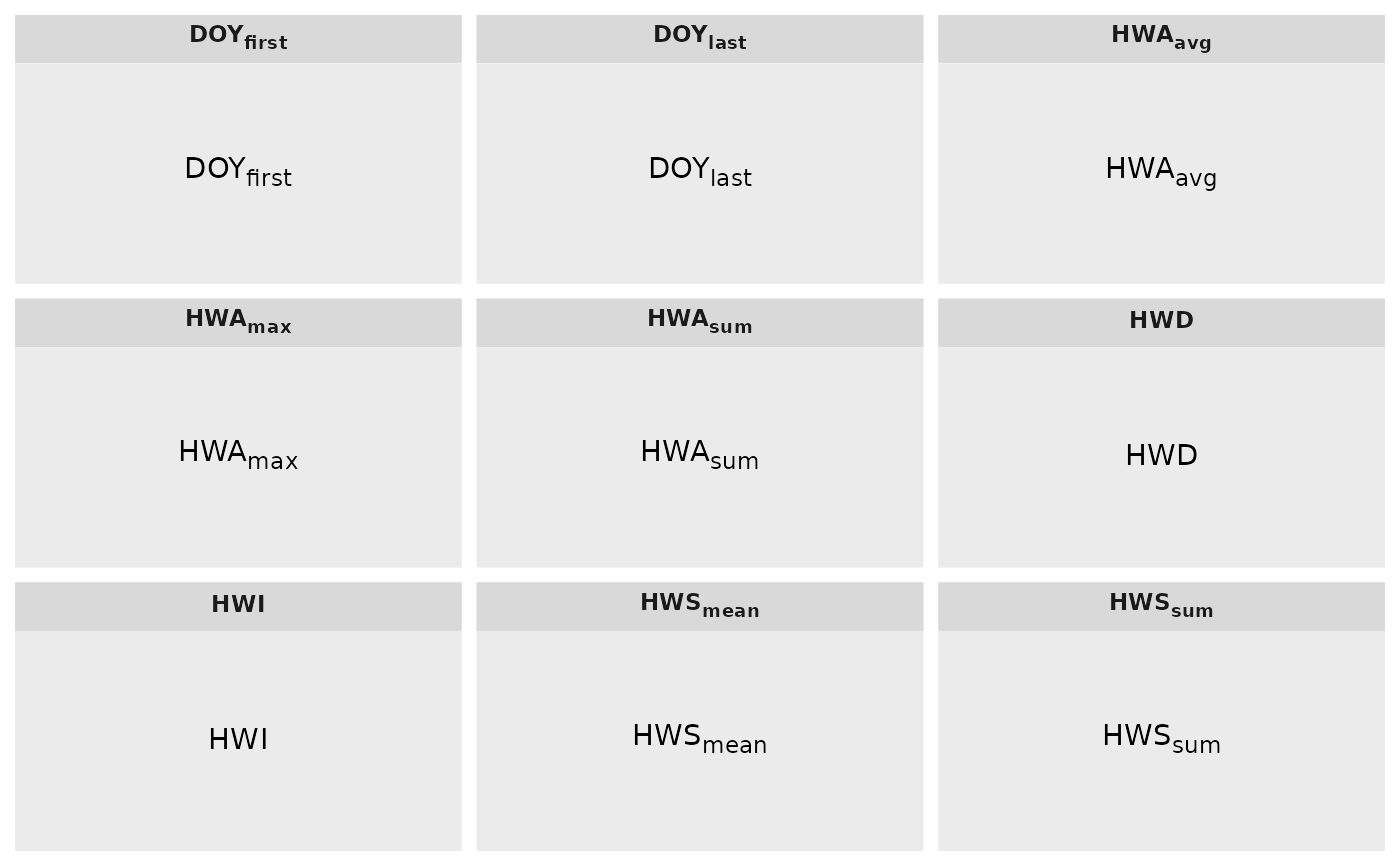Text with Normalised Parent Coordinates
geom_richtext_npc.RdText with Normalised Parent Coordinates
geom_richtext_npc(
mapping = NULL,
data = NULL,
stat = "identity",
position = "identity",
...,
nudge_x = 0,
nudge_y = 0,
label.padding = unit(c(0.25, 0.25, 0.25, 0.25), "lines"),
label.margin = unit(c(0, 0, 0, 0), "lines"),
label.r = unit(0.15, "lines"),
na.rm = FALSE,
show.legend = FALSE,
inherit.aes = FALSE
)
annotate_richtext_npc(x, y, label, size = 5, family = "", ...)
annotate_richlabel_npc(
x,
y,
label,
size = 5,
family = "",
fill = "white",
label.color = "black",
...
)
annotate_label_npc(
x,
y,
label,
size = 5,
family = "",
fill = "white",
label.color = "black",
...
)Arguments
- mapping
Set of aesthetic mappings created by
aes()oraes_(). If specified andinherit.aes = TRUE(the default), it is combined with the default mapping at the top level of the plot. You must supplymappingif there is no plot mapping.- data
The data to be displayed in this layer. There are three options:
If
NULL, the default, the data is inherited from the plot data as specified in the call toggplot().A
data.frame, or other object, will override the plot data. All objects will be fortified to produce a data frame. Seefortify()for which variables will be created.A
functionwill be called with a single argument, the plot data. The return value must be adata.frame, and will be used as the layer data. Afunctioncan be created from aformula(e.g.~ head(.x, 10)).- stat
The statistical transformation to use on the data for this layer, as a string.
- position
Position adjustment, either as a string, or the result of a call to a position adjustment function. Cannot be jointy specified with
nudge_xornudge_y.- ...
Other arguments passed on to
layer(). These are often aesthetics, used to set an aesthetic to a fixed value, likecolour = "red"orsize = 3. They may also be parameters to the paired geom/stat.- nudge_x
Horizontal and vertical adjustment to nudge labels by. Useful for offsetting text from points, particularly on discrete scales. Cannot be jointly specified with
position.- nudge_y
Horizontal and vertical adjustment to nudge labels by. Useful for offsetting text from points, particularly on discrete scales. Cannot be jointly specified with
position.- label.padding
Amount of padding around label. Defaults to 0.25 lines.
- label.margin
Unit vector of length four specifying the margin outside the text label.
- label.r
Radius of rounded corners. Defaults to 0.15 lines.
- na.rm
If
FALSE, the default, missing values are removed with a warning. IfTRUE, missing values are silently removed.- show.legend
logical. Should this layer be included in the legends?
NA, the default, includes if any aesthetics are mapped.FALSEnever includes, andTRUEalways includes. It can also be a named logical vector to finely select the aesthetics to display.- inherit.aes
If
FALSE, overrides the default aesthetics, rather than combining with them. This is most useful for helper functions that define both data and aesthetics and shouldn't inherit behaviour from the default plot specification, e.g.borders().- x
A numeric vector or unit object specifying x-values.
- y
A numeric vector or unit object specifying y-values.
- label
A character or expression vector. Other objects are coerced by
as.graphicsAnnot.
Aesthetics
geom_richtext() understands the following aesthetics (required
aesthetics are in bold; select aesthetics are annotated):
xylabelalphaanglecolourDefault color of label text and label outline.familyfontfacefillDefault fill color of label background.grouphjustlabel.colourColor of label outline. Overridescolour.label.sizeWidth of label outline.lineheightsizeDefault font size of label text.text.colourColor of label text. Overridescolour.vjust
See also
Examples
library(ggplot2)
## first example
labels <- c(
"gC m^{-2} d^{-1}",
"gC m^-2 d^-1",
"gC m_{-2} d_{-1}",
"gC m_-2 d_-1"
# "gC \n mm/d"
)
x = 0.2
y = seq_along(labels)/10
ggplot() + annotate_richtext_npc(x, y, labels, size = 5)
 ggplot() + annotate_richlabel_npc(x, y, labels, size = 5, label.color = "red")
ggplot() + annotate_richlabel_npc(x, y, labels, size = 5, label.color = "red")
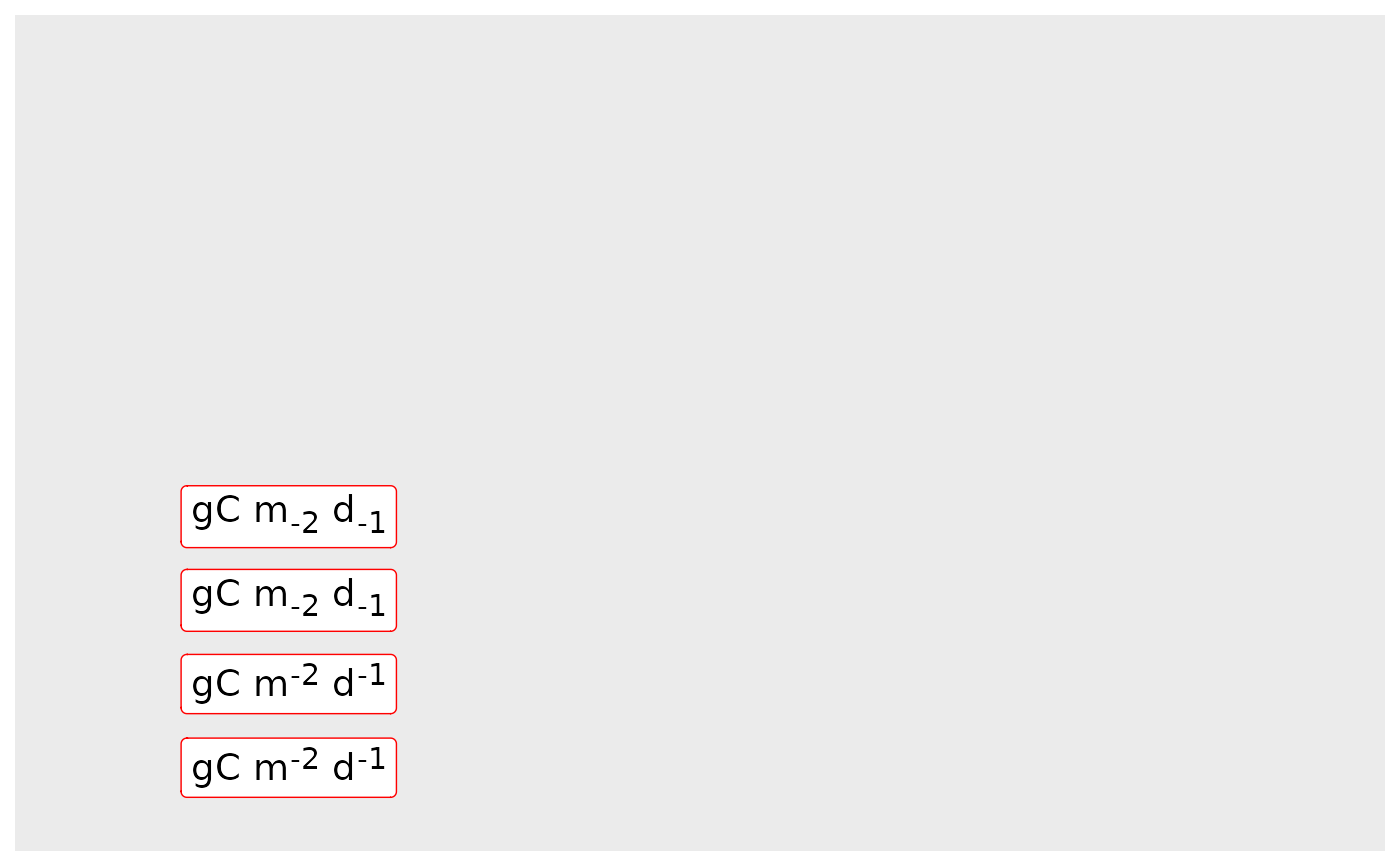 # Another option
d = data.frame(x = 0.2, y = seq_along(labels)/10, label = labels)
ggplot(d, aes(npcx = x, npcy = y)) +
geom_richtext_npc(aes(npcx = x, npcy = y, label = label))
# Another option
d = data.frame(x = 0.2, y = seq_along(labels)/10, label = labels)
ggplot(d, aes(npcx = x, npcy = y)) +
geom_richtext_npc(aes(npcx = x, npcy = y, label = label))
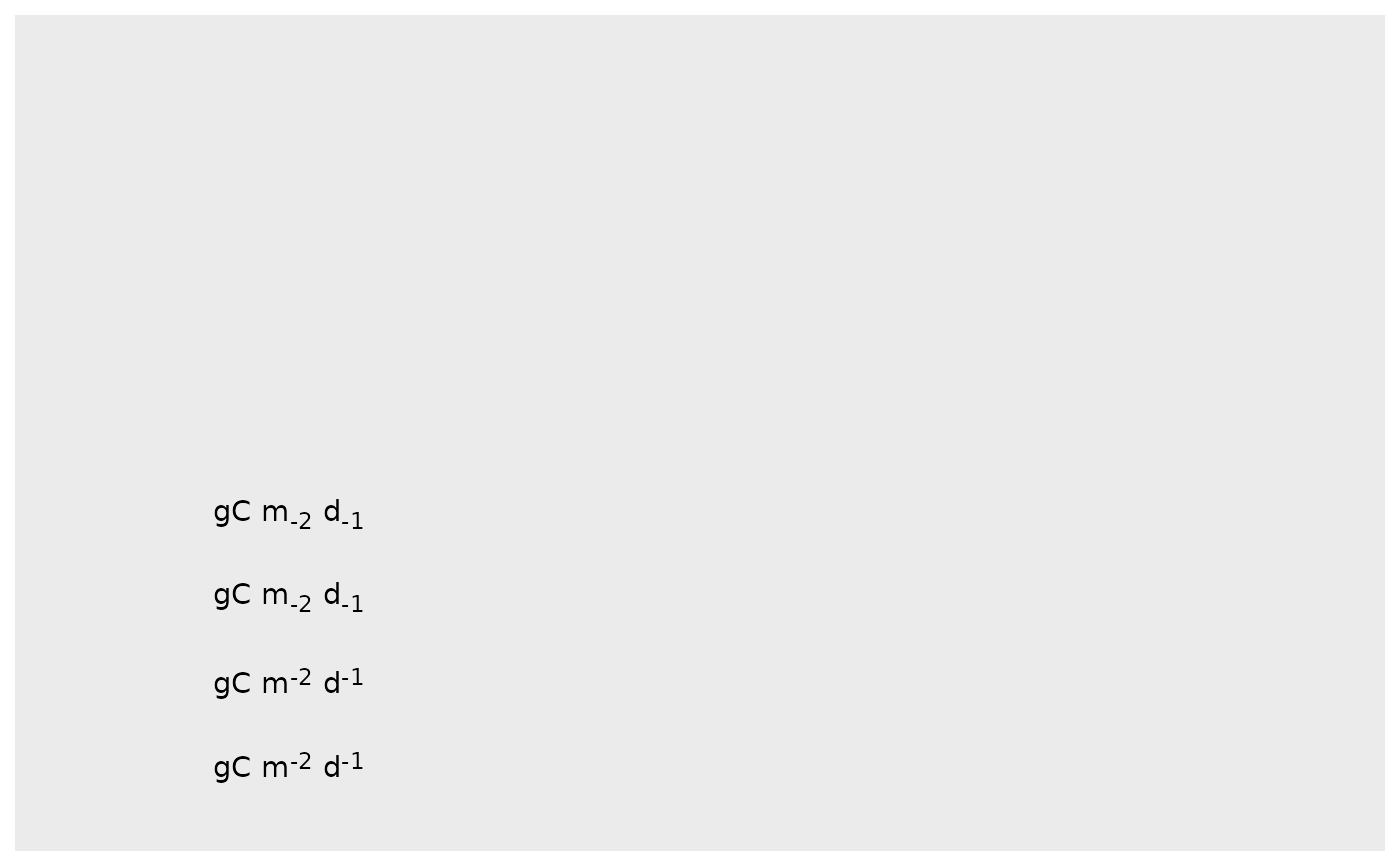 # remove fill and label.color
ggplot(d, aes(npcx = x, npcy = y)) +
geom_richtext_npc(aes(npcx = x, npcy = y, label = label),
fill = "white", label.color = "red")
# remove fill and label.color
ggplot(d, aes(npcx = x, npcy = y)) +
geom_richtext_npc(aes(npcx = x, npcy = y, label = label),
fill = "white", label.color = "red")
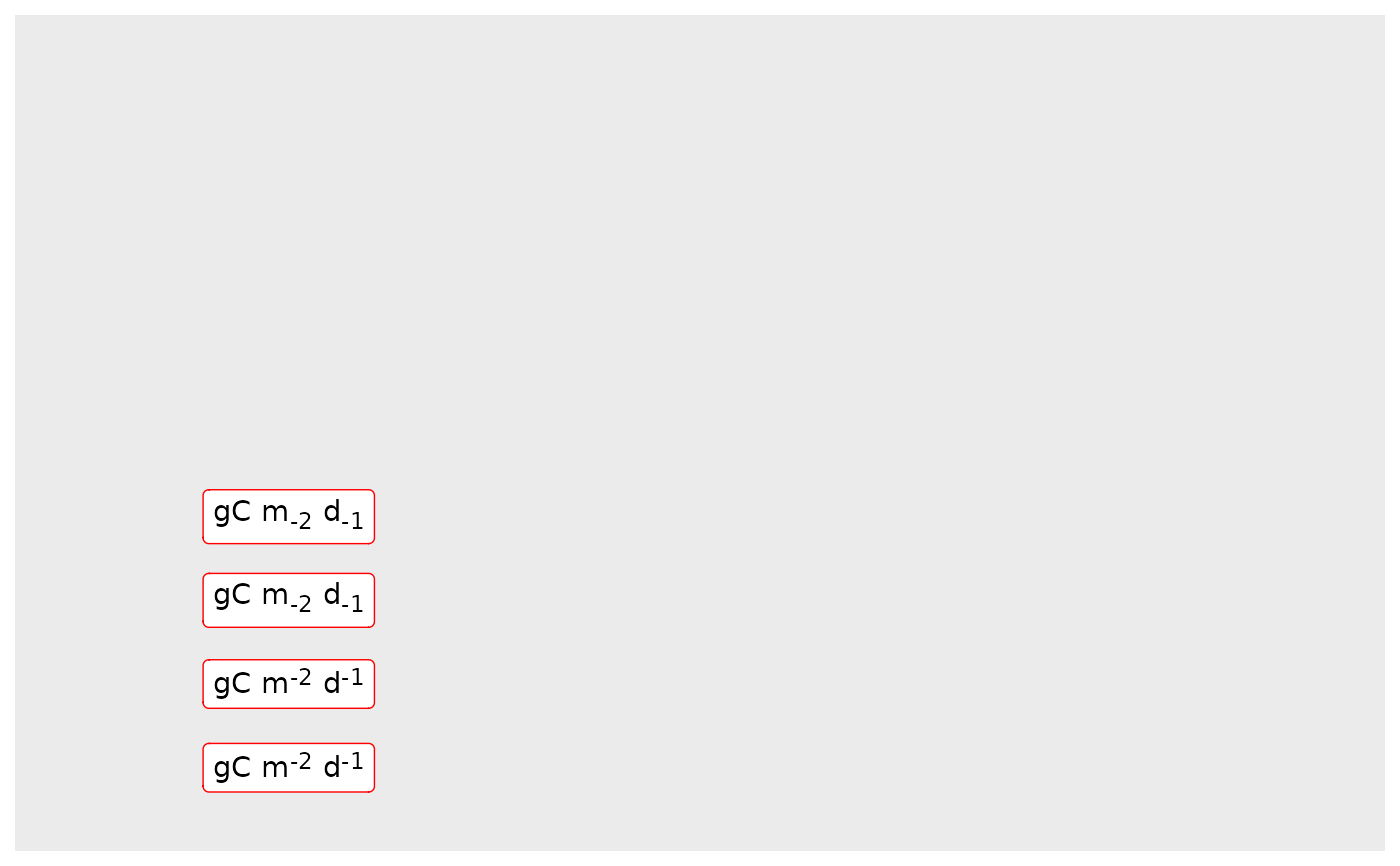 ## second example
d$label <- c(
"Some text **in bold.**",
"Linebreaks<br>Linebreaks<br>Linebreaks",
"*x*<sup>2</sup> + 5*x* + *C*<sub>*i*</sub>",
"Some <span style='color:blue'>blue text **in bold.**</span><br>And
*italics text.*<br>
And some <span style='font-size:18pt; color:black'>large</span> text."
)
ggplot(d, aes(npcx = x, npcy = y)) +
geom_richtext_npc(aes(npcx = x, npcy = y, label = label))
## second example
d$label <- c(
"Some text **in bold.**",
"Linebreaks<br>Linebreaks<br>Linebreaks",
"*x*<sup>2</sup> + 5*x* + *C*<sub>*i*</sub>",
"Some <span style='color:blue'>blue text **in bold.**</span><br>And
*italics text.*<br>
And some <span style='font-size:18pt; color:black'>large</span> text."
)
ggplot(d, aes(npcx = x, npcy = y)) +
geom_richtext_npc(aes(npcx = x, npcy = y, label = label))
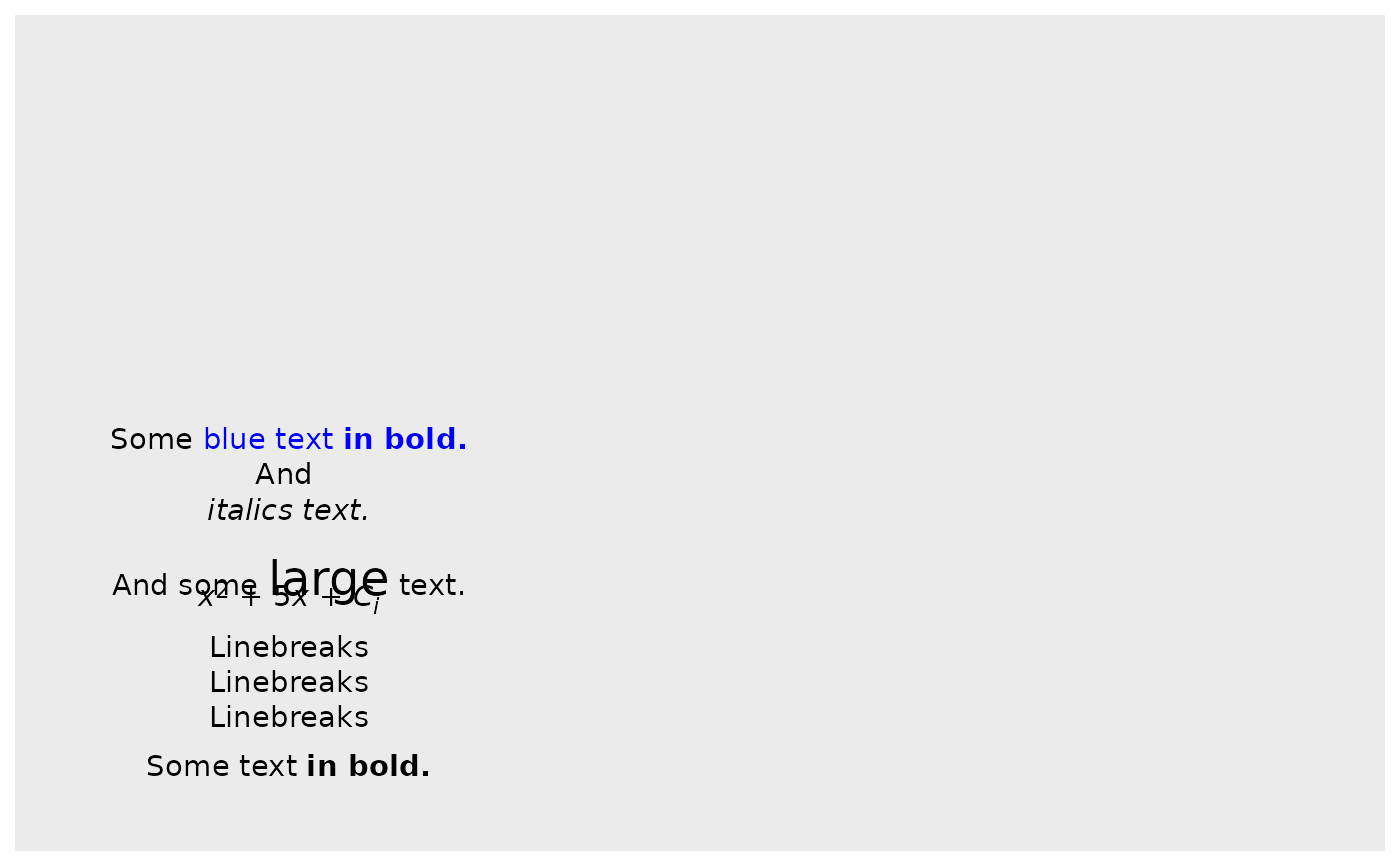 ## test for `str_mk`
library(magrittr)
indexes_lev = c("DOY_first", "DOY_last", "HWD", "HWI", "HWS_mean",
"HWS_sum", "HWA_avg", "HWA_max", "HWA_sum")
labels = indexes_lev %>% str_mk() #%>% label_tag(expression = F)
d = data.frame(x = 0.5, y = 0.5, label = labels)
ggplot(d) +
facet_wrap(~label) +
theme(strip.text.x = element_textbox(face = "bold")) +
geom_richtext_npc(aes(npcx = x, npcy = y, label = label))
## test for `str_mk`
library(magrittr)
indexes_lev = c("DOY_first", "DOY_last", "HWD", "HWI", "HWS_mean",
"HWS_sum", "HWA_avg", "HWA_max", "HWA_sum")
labels = indexes_lev %>% str_mk() #%>% label_tag(expression = F)
d = data.frame(x = 0.5, y = 0.5, label = labels)
ggplot(d) +
facet_wrap(~label) +
theme(strip.text.x = element_textbox(face = "bold")) +
geom_richtext_npc(aes(npcx = x, npcy = y, label = label))
